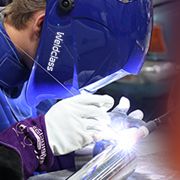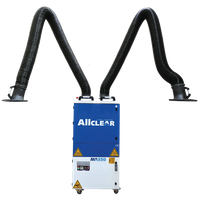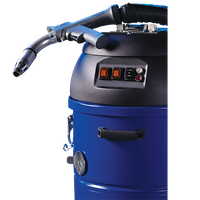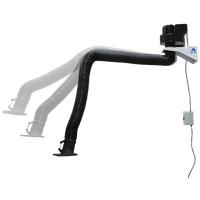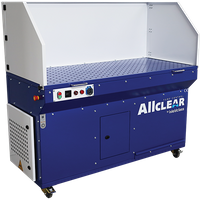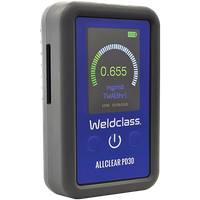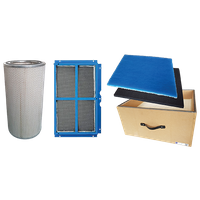ALLCLEAR Welding Fume Extractors | Welding Fume Control

Welding fumes aren’t just harmless smoke—they’re a mix of fine metal particles, gases, and chemical vapours that can cause serious long-term health issues. Since 2024, strict nationwide legislation has set high standards for fume control in Australia. For anyone welding regularly, having an effective fume management strategy is essential.
ALLCLEAR® Fume Control products by Weldclass Australia offers a range of tried, tested and proven solutions for extraction, filtration, and monitoring of welding fumes.
Looking for a welding fume extractor? Check out the comprehensive welding fume extractor guide here.
Chosing The Right Fume Extractor Request Quote or Demo
Helmet, Mobile, Torch, or Table - What is the Best Fume Solution?
The most common types of fume protection and control are PAPR welding helmets, Mobile Fume Extractors, On-Torch Extractors, and Downdraft Tables. Each method has advantages and disadvantages, and there is no one single extractor that suits all welding applications. In this guide we compare fume extractor types by application, and explain the pros and cons of each.
Why Some Fume Extractors REALLY Suck (and some don't)
A fume extractor might seem like a simple device — just a box with a fan and a filter. In reality, though, design differences between brands and models can significantly affect how effectively the unit performs its job. Read here about why some extractors remove fumes better than others.
What is LEV? What are LEVs?
In the context of fume control, LEV is an acronym for Local Exhaust Ventilation. LEV systems are designed to capture and remove airborne contaminants, such as welding fumes, directly at the source before they can disperse into the workplace environment. This helps to protect workers from inhaling harmful substances and ensures compliance with occupational health and safety regulations.
Key components of an LEV system typically include:
- Hood: Positioned close to the source of fumes, it captures the contaminants.
- Ducting: Transports the captured fumes away from the source.
- Filter: Removes contaminants from the air.
- Fan: Creates the necessary airflow to move the fumes through the system.
- Discharge Outlet: Safely expels the cleaned air.
By using an LEV system, employers can significantly reduce the concentration of hazardous fumes in the air, thus protecting the health of welders and other workers in the vicinity.
While LEVs technically include many different types of fume extraction units - including down-draft fume extraction tables, and wall-mounted fans and extractors - the term "LEV" is most commonly used for portable, or mobile, welding fume extractors.
Welding Fume Extractors Explained
In this video we explore the how, what, and why of mobile welding smoke extractors.
Welding Fume Extractors Australia
ALLCLEAR® fume extractors have been tried, tested, and proven in Australia for over 15 years. Acquired by Weldclass in 2024, ALLCLEAR® units now come with our signature 7 Year Warranty offer for complete peace of mind.
Breathing Easy: The Advantages of a Welding Fume Extractor in the Workplace
Breathing Easy: The Benefits of a Welding Fume Extractor in the Workplace
In a bustling workplace where the sparks fly, the safety and wellbeing of employees should always be a top priority. When it comes to welding, the release of harmful fumes and particles into the air poses a serious health risk. That's where a welding fume extractor comes into play.
A welding fume extractor, with its advanced filtration system, works to remove hazardous particles and pollutants from the air, ensuring a safer and healthier environment for workers. By capturing and filtering out the noxious fumes, these devices help protect employees from respiratory issues and long-term health complications.
Not only does a welding fume extractor prioritize employee health, but it also safeguards equipment and improves productivity. By reducing the buildup of fumes and contaminants, it helps maintain a clean working environment, minimizing the risk of equipment damage and optimizing performance.
Investing in a quality welding fume extractor not only demonstrates a commitment to employee safety, but it also aligns with regulatory compliance and promotes a positive work culture. With the advantages it offers, a welding fume extractor is a must-have tool for any workplace engaged in welding operations.
Breathe easy and prioritize safety with a welding fume extractor in your workplace today.
Importance of workplace safety in welding
Welding is an essential process in numerous industries, from manufacturing and construction to automotive and shipbuilding. It is a highly skilled task that requires the utmost attention to safety. In the welding environment, workers are exposed to a variety of hazards, including intense heat, sparks, and the release of harmful fumes and particles into the air. Ensuring the safety of these employees should be a top priority for any responsible employer.
Workplace safety is not just a moral obligation, but it is also a legal requirement. Regulatory bodies, such as the Occupational Safety and Health Administration (OSHA) in the United States, have established strict guidelines and standards to protect workers from the dangers associated with welding. Failure to comply with these regulations can result in hefty fines and legal consequences, not to mention the potential for devastating workplace accidents and injuries.
By prioritizing safety in the welding workplace, employers can not only protect their employees but also safeguard the overall productivity and efficiency of their operations. When workers feel secure and confident in their work environment, they are more likely to be engaged, motivated, and committed to their tasks. This, in turn, can lead to improved quality of work, reduced absenteeism, and a more positive company culture.
Health risks associated with welding fumes
Welding fumes are a complex mixture of metal oxides, silicates, and other particulates that are generated during the welding process. These fumes can contain a variety of hazardous substances, including lead, chromium, and manganese, which can have serious health consequences for workers.
Inhaling welding fumes can lead to a range of respiratory issues, including metal fume fever, bronchitis, and pneumonia. Prolonged exposure can also contribute to the development of more severe conditions, such as lung cancer, Parkinson's disease, and neurological disorders. The effects of welding fumes can be particularly detrimental to workers with pre-existing respiratory conditions, such as asthma or COPD.
In addition to respiratory problems, welding fumes can also cause other health concerns, such as skin irritation, eye irritation, and even reproductive issues. The specific health risks associated with welding fumes can vary depending on the type of metal being welded, the welding process used, and the duration and frequency of exposure.
Benefits of using a welding fume extractor
The use of a welding fume extractor in the workplace offers a range of benefits that can improve the health and safety of workers, as well as the overall efficiency of the operation.
One of the primary benefits of a welding fume extractor is its ability to capture and remove harmful fumes and particles from the air. By filtering out these hazardous substances, the extractor helps to reduce the risk of respiratory issues and other health problems among welders and nearby employees. This not only protects the workers but also helps to maintain a cleaner and more breathable work environment.
In addition to improving air quality, a welding fume extractor can also help to extend the lifespan of equipment and machinery. By preventing the buildup of fumes and contaminants, the extractor can help to reduce the risk of equipment failure and the need for costly repairs or replacements. This, in turn, can lead to increased productivity and cost savings for the business.
Furthermore, the use of a welding fume extractor can demonstrate a company's commitment to workplace safety and environmental responsibility. This can improve the company's reputation and attract new clients or customers who value these qualities. Additionally, compliance with safety regulations and the reduction of workplace incidents can lead to lower insurance premiums and other cost savings.
Types of welding fume extractors
There are several different types of welding fume extractors available on the market, each with its own unique features and capabilities. Understanding the various options can help employers choose the best solution for their specific workplace needs.
One of the most common types of welding fume extractors is the portable or mobile unit. These compact and maneuverable devices can be easily moved around the workspace, allowing for flexibility in their placement and use. Portable welding fume extractors are often equipped with flexible hoses or arms that can be positioned directly over the welding area, ensuring effective capture and filtration of the fumes.
Another type of welding fume extractor is the stationary or fixed unit. These larger, more permanent installations are typically mounted on the wall or ceiling and are designed to provide comprehensive coverage of a designated welding area. Stationary welding fume extractors often feature more advanced filtration systems and higher airflow capacities, making them well-suited for high-volume or large-scale welding operations.
In addition to these traditional options, there are also specialized welding fume extractors designed for specific applications or welding processes. For example, some models are optimized for use with MIG or TIG welding, while others are engineered to handle the unique challenges of stainless steel or aluminum welding. Employers should carefully consider the specific requirements of their welding operations when selecting the appropriate type of welding fume extractor.
Factors to consider when choosing a welding fume extractor
When selecting a welding fume extractor for the workplace, there are several key factors that employers should consider to ensure they choose the most suitable and effective solution.
One of the primary factors to consider is the size and layout of the welding area. The extractor should be capable of providing sufficient airflow and coverage to effectively capture and filter the fumes generated by the welding process. Employers should carefully measure the dimensions of the workspace and consult with the extractor manufacturer to determine the appropriate size and configuration of the unit.
Another important factor is the type of welding being performed. Different welding processes, such as MIG, TIG, or stick welding, can produce varying levels and compositions of fumes. Employers should select a welding fume extractor that is specifically designed to handle the specific welding processes used in their workplace, ensuring optimal performance and filtration efficiency.
The level of filtration required is also a crucial consideration. Welding fume extractors can be equipped with a range of filtration media, including HEPA (high-efficiency particulate air) filters, activated carbon filters, and specialized media for the removal of specific pollutants. Employers should carefully evaluate the potential hazards and contaminants present in their welding environment and choose a unit with the appropriate filtration capabilities.
Other factors to consider include the noise level of the extractor, its energy efficiency, and its ease of installation and maintenance. Employers should also evaluate the overall cost of the extractor, including both the initial purchase price and the ongoing operating and maintenance expenses.
Installation and maintenance of welding fume extractors
Proper installation and regular maintenance of a welding fume extractor are essential for ensuring its optimal performance and longevity.
When it comes to installation, the location of the extractor is critical. The unit should be positioned as close to the welding area as possible, ensuring that the capture hood or arm is positioned to effectively draw in the fumes and particles. Employers should also consider the placement of the extractor's exhaust, ensuring that it is directed away from the work area and any nearby air intakes or ventilation systems.
In addition to proper placement, the extractor must be correctly connected to the building's electrical and ductwork systems. This may require the assistance of a qualified electrician or HVAC technician to ensure the proper integration and safe operation of the device.
Ongoing maintenance is also crucial for maintaining the effectiveness of a welding fume extractor. This includes regular cleaning and inspection of the filtration media, as well as the replacement of filters and other consumable components as needed. Employers should follow the manufacturer's recommended maintenance schedule and use only genuine replacement parts to ensure the extractor's continued performance.
Proper maintenance not only helps to maintain the efficiency of the welding fume extractor but also extends its lifespan. By investing in regular maintenance, employers can avoid costly breakdowns or the need for premature replacement, ultimately saving money and ensuring a safer work environment for their employees.
Case studies of companies using welding fume extractors
The benefits of using a welding fume extractor in the workplace are well-documented, and many companies have experienced firsthand the positive impact these devices can have on their operations.
One such example is a manufacturing company that specializes in the production of heavy equipment. Prior to implementing a welding fume extractor, the company had struggled with high rates of respiratory illnesses among its welding staff, leading to increased absenteeism and reduced productivity. After installing a state-of-the-art welding fume extractor, the company saw a significant reduction in respiratory issues, with employees reporting improved breathing and fewer instances of metal fume fever.
Another case study involves a shipbuilding company that faced similar challenges with welding fume exposure. Recognising the importance of protecting its workers, the company invested in a comprehensive welding fume extraction system, which included both portable and stationary units strategically placed throughout the shipyard. The result was a dramatic improvement in air quality, with workers reporting a significant reduction in respiratory symptoms and a more comfortable work environment.
The installation of the welding fume extractor also had a positive impact on the company's safety record and regulatory compliance. By demonstrating a strong commitment to worker health and safety, the shipbuilding company was able to reduce the number of workplace incidents and avoid costly fines or penalties from regulatory bodies.
Cost-effectiveness of welding fume extractors
While the initial investment in a welding fume extractor may seem significant, the long-term cost savings and benefits can make it a highly cost-effective solution for businesses.
One of the primary ways in which a welding fume extractor can provide cost savings is through the reduction of worker-related expenses. By improving air quality and reducing the risk of respiratory issues and other health problems, the extractor can help to lower absenteeism, workers' compensation claims, and healthcare costs associated with employee illnesses.
Additionally, the extractor's ability to extend the lifespan of welding equipment and machinery can lead to significant cost savings. By preventing the buildup of fumes and contaminants, the extractor helps to minimize the need for costly repairs and replacements, allowing businesses to maximize their investment in their equipment.
In some cases, the installation of a welding fume extractor can also help businesses avoid costly fines or penalties from regulatory bodies. By demonstrating compliance with workplace safety and environmental regulations, companies can avoid the financial burden of non-compliance, which can include hefty fines, legal fees, and even the temporary shutdown of operations.
Furthermore, the use of a welding fume extractor can enhance a company's reputation and brand image, making it more attractive to potential clients or customers who value workplace safety and environmental responsibility. This can lead to increased business opportunities and revenue, further contributing to the overall cost-effectiveness of the investment.
Conclusion: Creating a safer work environment with welding fume extractors
In conclusion, the implementation of a welding fume extractor in the workplace is a crucial step in creating a safer and healthier environment for employees. By capturing and filtering out harmful fumes and particles, these devices help to protect workers from the serious health risks associated with welding, while also improving the overall efficiency and productivity of the operation.
From reducing respiratory issues and extending the lifespan of equipment to demonstrating a commitment to workplace safety and environmental responsibility, the benefits of a welding fume extractor are numerous and far-reaching. Employers who invest in these innovative solutions are not only prioritizing the wellbeing of their employees but also positioning their businesses for long-term success and sustainability.
As the importance of workplace safety continues to grow, the use of welding fume extractors will become increasingly essential for any business engaged in welding activities. By staying ahead of the curve and implementing these cutting-edge technologies, employers can create a safer, healthier, and more productive work environment for their employees, ultimately driving their organisations towards a brighter and more prosperous future.


